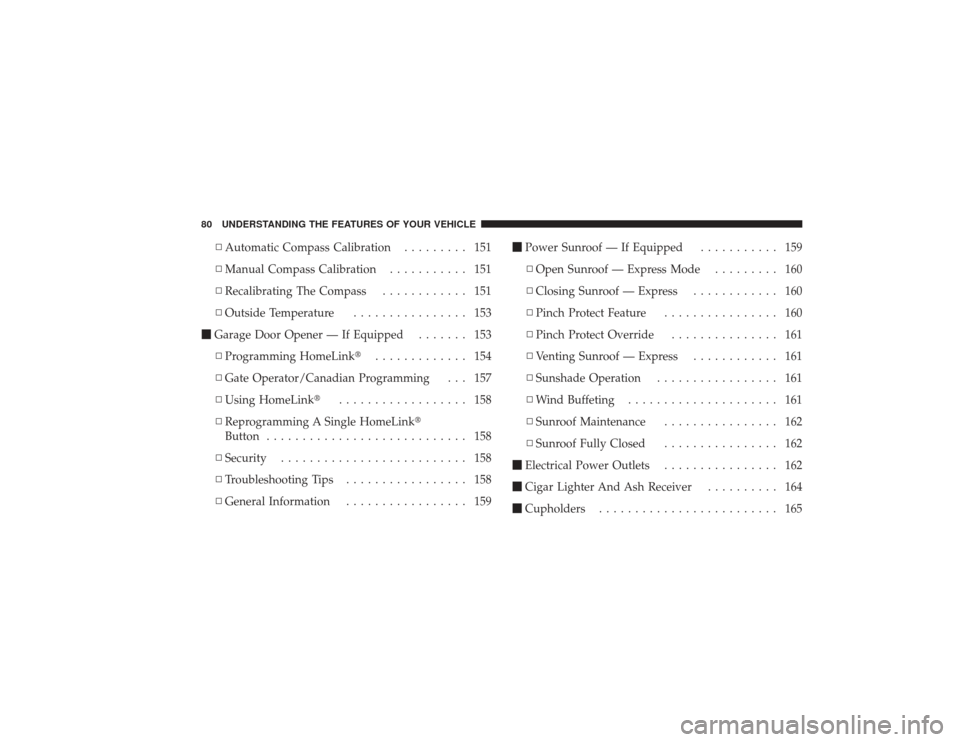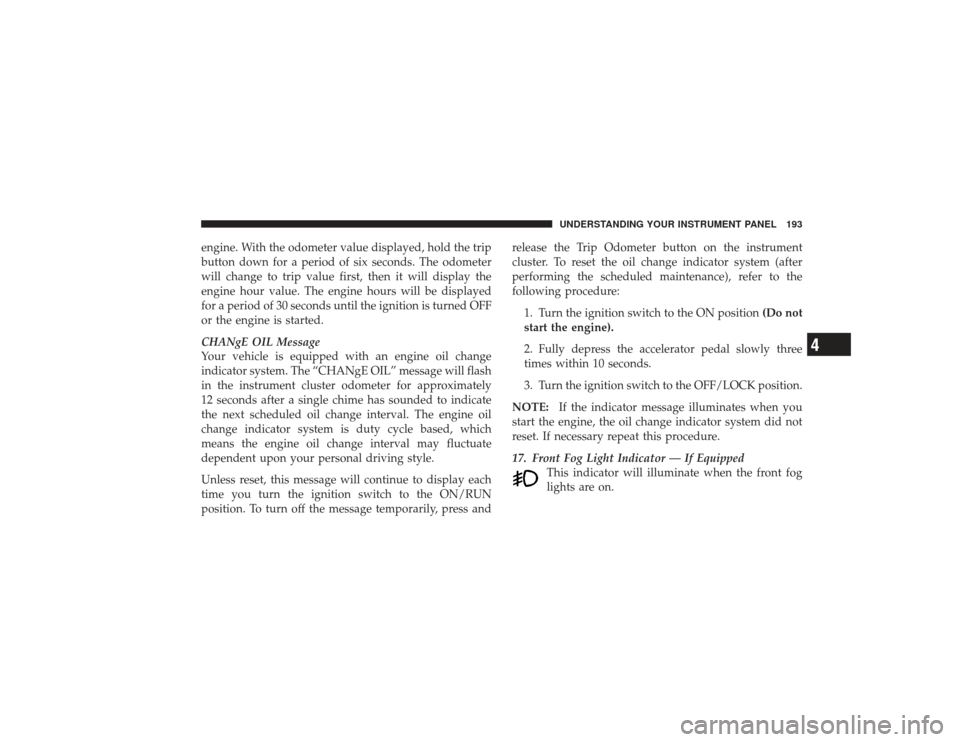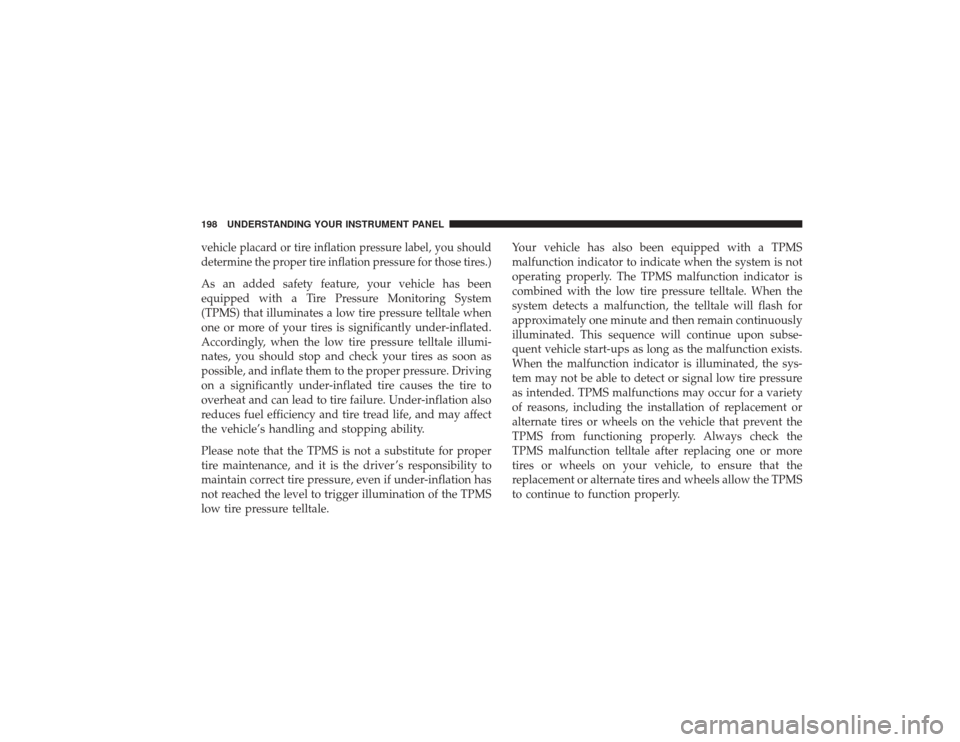Page 3 of 532
TABLE OF CONTENTS
SECTIONPAGE1
INTRODUCTION
.............................................................3
2
THINGS TO KNOW BEFORE STARTING YOUR VEHICLE
...............................9
3
UNDERSTANDING THE FEATURES OF YOUR VEHICLE
...............................77
4
UNDERSTANDING YOUR INSTRUMENT PANEL
................................... 181
5
STARTING AND OPERATING
................................................. 247
6
WHAT TO DO IN EMERGENCIES
...............................................405
7
MAINTAINING YOUR VEHICLE
............................................... 425
8
MAINTENANCE SCHEDULES
.................................................. 481
9
IF YOU NEED CONSUMER ASSISTANCE
..........................................499
10
INDEX
....................................................................509
1
2
3
4
5
6
7
8
910
Page 6 of 532

INTRODUCTIONThis Owner’s Manual has been prepared with the assis-
tance of service and engineering specialists to acquaint
you with the operation and maintenance of your vehicle.
It is supplemented by a Warranty Information Booklet
and various customer-oriented documents. You are
urged to read these publications carefully. Following the
instructions and recommendations in this manual will
help assure safe and enjoyable operation of your vehicle.
NOTE: After you read the manual, it should be stored
in the vehicle for convenient referencing and remain
with the vehicle when sold, so that the new owner will
be aware of all safety warnings.
When it comes to service, remember that your authorized
dealer knows your vehicle best, has the factory-trained
technicians and genuine Mopar�parts, and is interested
in your satisfaction.
HOW TO USE THIS MANUALConsult the Table of Contents to determine which section
contains the information you desire.
The detailed index at the back of this Owner’s Manual
contains a complete listing of all subjects.
Consult the following table for a description of the
symbols that may be used on your vehicle or throughout
this Owner’s Manual:
4 INTRODUCTION
Page 75 of 532

Transporting PetsAirbags deploying in the front seat could harm your pet.
An unrestrained pet will be thrown about and possibly
injured, or injure a passenger during panic braking or in
a collision. Pets should be restrained in the rear seat in
pet harnesses or pet carriers that are secured by seat belts.ENGINE BREAK-IN RECOMMENDATIONSA long break-in period is not required for the engine in
your vehicle.
Drive moderately during the first 300 miles (500 km).
After the initial 60 miles (100 km), speeds up to 50 or
55 mph (80 or 90 km/h) are desirable.
While cruising, brief full-throttle acceleration within the
limits of local traffic laws, contributes to a good break-in.
Wide-open throttle acceleration in low gear can be detri-
mental and should be avoided.The engine oil installed in the engine at the factory is a
high-quality energy conserving type lubricant. Oil
changes should be consistent with anticipated climate
conditions under which vehicle operations will occur.
The recommended viscosity and quality grades are
shown in “Engine Oil”, under “Maintenance Procedures”
in section 7 of this manual. NON-DETERGENT OR
STRAIGHT MINERAL OILS MUST NEVER BE USED.
A new engine may consume some oil during its first few
thousand miles (kilometers) of operation. This should be
considered a normal part of the break-in and not inter-
preted as an indication of difficulty.
THINGS TO KNOW BEFORE STARTING YOUR VEHICLE 73
2
Page 82 of 532

▫Automatic Compass Calibration ......... 151
▫ Manual Compass Calibration ........... 151
▫ Recalibrating The Compass ............ 151
▫ Outside Temperature ................ 153
� Garage Door Opener — If Equipped ....... 153
▫ Programming HomeLink� ............. 154
▫ Gate Operator/Canadian Programming . . . 157
▫ Using HomeLink� .................. 158
▫ Reprogramming A Single HomeLink�
Button ............................ 158
▫ Security .......................... 158
▫ Troubleshooting Tips ................. 158
▫ General Information ................. 159 �
Power Sunroof — If Equipped ........... 159
▫ Open Sunroof — Express Mode ......... 160
▫ Closing Sunroof — Express ............ 160
▫ Pinch Protect Feature ................ 160
▫ Pinch Protect Override ............... 161
▫ Venting Sunroof — Express ............ 161
▫ Sunshade Operation ................. 161
▫ Wind Buffeting ..................... 161
▫ Sunroof Maintenance ................ 162
▫ Sunroof Fully Closed ................ 162
� Electrical Power Outlets ................ 162
� Cigar Lighter And Ash Receiver .......... 164
� Cupholders ......................... 165
80 UNDERSTANDING THE FEATURES OF YOUR VEHICLE
Page 164 of 532
Sunroof MaintenanceUse only a non-abrasive cleaner and a soft cloth to clean
the glass panel.Sunroof Fully ClosedPress the switch forward and release to ensure that the
sunroof is fully closed.ELECTRICAL POWER OUTLETSThe auxiliary electrical power outlet can provide power
for in-cab accessories designed for use with the standard
“cigar lighter” plug. The power outlet is located in the
instrument panel, below and to the right of the climate
control panel. A cap is attached to the outlet base
indicating “Power Outlet” 12-Volt/20 A.There is an additional power outlet inside the center
console of vehicle’s equipped with 40-20-40, or bucket
front seats.
Front Power Outlet
162 UNDERSTANDING THE FEATURES OF YOUR VEHICLE
Page 185 of 532
▫Using The PTY (Program Type) Button —
If Equipped ........................ 229
▫ PTY Button Scan ................... 230
▫ PTY Button Seek ................... 230
▫ Satellite Antenna ................... 230
▫ Reception Quality ................... 230
� Video Entertainment System (VES)™ —
If Equipped .......................... 231
� Remote Sound System Controls —
If Equipped .......................... 231
▫ Radio Operation .................... 232
▫ CD Player ........................ 232 �
CD/DVD Maintenance ................ 232
� Radio Operation And Cellular Phones ...... 233
� Climate Controls ..................... 234
▫ Heater Only — If Equipped ............ 234
▫ Air Conditioning And Heating —
If Equipped ........................ 237
▫ Air Conditioning With Dual Zone
Temperature Control — If Equipped ....... 240
▫ Operating Tips ..................... 244
▫ Operating Tips Chart ................ 246
UNDERSTANDING YOUR INSTRUMENT PANEL 183
4
Page 195 of 532

engine. With the odometer value displayed, hold the trip
button down for a period of six seconds. The odometer
will change to trip value first, then it will display the
engine hour value. The engine hours will be displayed
for a period of 30 seconds until the ignition is turned OFF
or the engine is started.
CHANgE OIL Message
Your vehicle is equipped with an engine oil change
indicator system. The “CHANgE OIL” message will flash
in the instrument cluster odometer for approximately
12 seconds after a single chime has sounded to indicate
the next scheduled oil change interval. The engine oil
change indicator system is duty cycle based, which
means the engine oil change interval may fluctuate
dependent upon your personal driving style.
Unless reset, this message will continue to display each
time you turn the ignition switch to the ON/RUN
position. To turn off the message temporarily, press andrelease the Trip Odometer button on the instrument
cluster. To reset the oil change indicator system (after
performing the scheduled maintenance), refer to the
following procedure:
1. Turn the ignition switch to the ON position (Do not
start the engine).
2. Fully depress the accelerator pedal slowly three
times within 10 seconds.
3. Turn the ignition switch to the OFF/LOCK position.
NOTE: If the indicator message illuminates when you
start the engine, the oil change indicator system did not
reset. If necessary repeat this procedure.
17. Front Fog Light Indicator — If Equipped This indicator will illuminate when the front fog
lights are on.
UNDERSTANDING YOUR INSTRUMENT PANEL 193
4
Page 200 of 532

vehicle placard or tire inflation pressure label, you should
determine the proper tire inflation pressure for those tires.)As an added safety feature, your vehicle has been
equipped with a Tire Pressure Monitoring System
(TPMS) that illuminates a low tire pressure telltale when
one or more of your tires is significantly under-inflated.
Accordingly, when the low tire pressure telltale illumi-
nates, you should stop and check your tires as soon as
possible, and inflate them to the proper pressure. Driving
on a significantly under-inflated tire causes the tire to
overheat and can lead to tire failure. Under-inflation also
reduces fuel efficiency and tire tread life, and may affect
the vehicle’s handling and stopping ability.
Please note that the TPMS is not a substitute for proper
tire maintenance, and it is the driver ’s responsibility to
maintain correct tire pressure, even if under-inflation has
not reached the level to trigger illumination of the TPMS
low tire pressure telltale.Your vehicle has also been equipped with a TPMS
malfunction indicator to indicate when the system is not
operating properly. The TPMS malfunction indicator is
combined with the low tire pressure telltale. When the
system detects a malfunction, the telltale will flash for
approximately one minute and then remain continuously
illuminated. This sequence will continue upon subse-
quent vehicle start-ups as long as the malfunction exists.
When the malfunction indicator is illuminated, the sys-
tem may not be able to detect or signal low tire pressure
as intended. TPMS malfunctions may occur for a variety
of reasons, including the installation of replacement or
alternate tires or wheels on the vehicle that prevent the
TPMS from functioning properly. Always check the
TPMS malfunction telltale after replacing one or more
tires or wheels on your vehicle, to ensure that the
replacement or alternate tires and wheels allow the TPMS
to continue to function properly.198 UNDERSTANDING YOUR INSTRUMENT PANEL